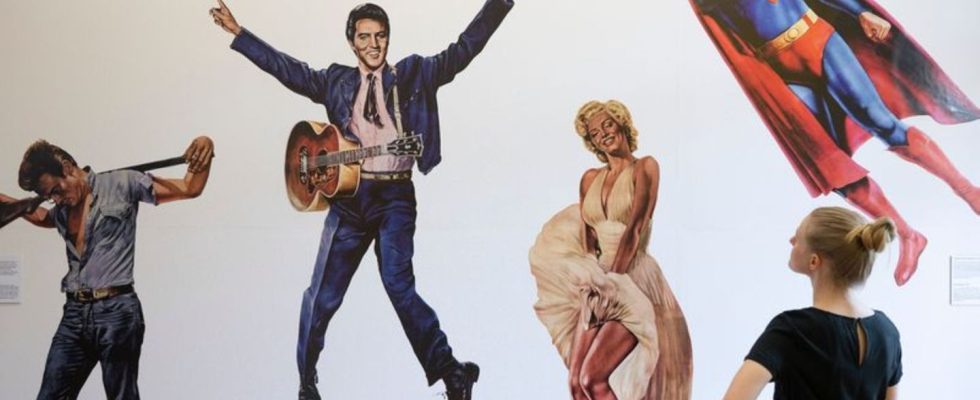Company
The “Bravo star cut” – from the youth room to the museum
A total of 45 reprinted puzzle posters can be seen in Rüsselsheim. photo
© Boris Roessler/dpa
From ABBA to Madonna: “Bravo” star cuts once adorned young people’s rooms. Now an exhibition takes visitors on a journey through time – and reminds them of an object that would hardly work today.
Brigitte Bardot started things off. Or more precisely her feet – in black pumps and fishnet tights. In March 1959, “Bravo” put on the first part of their very first star cut. “A little piece of Brigittchen” will now be published in the following issues – to cut out and stick on, the youth magazine said at the time. Nine more parts followed the feet. Whoever collected them all could “have at home the entire petite figure of France’s living monument in full size. 156 cm Brigitte Bardot!”
All of this can be read and looked at in the Opel villas in Rüsselsheim, Hesse. From this Sunday on, the exhibition “”Bravo”-Starschnitte. A collection of legends” will be shown there. You can see a total of 45 reprinted puzzle posters between 1959 and 2004, which document a very Western star cult. The show not only gives insights into youth cultures long gone, but also reminds us of society in the decades between post-war stuffiness and digitization.
“For visitors, it’s a journey through time,” says curator Beate Kemfert. In addition to Bardot, a star cut by Peter Kraus can be seen. The Beatles and Elvis Presley follow twice. Marilyn Monroe and James Dean are on display, as are Mick Jagger and ABBA – including musical accompaniment. A Madonna kneeling on the floor is shown from the 1980s, but also Modern Talking, Boris Becker or the extraterrestrial ET. Rapper Eminem is from the millennium era.
Star cuts as a provocation and demarcation
“Star cuts were something special. The “Bravo” shaped generations of teenagers, but was also forbidden in many households,” says art historian Kemfert. “We also have star cuts from shock rockers like Kiss or Alice Cooper – or from the Village People group, which was celebrated in the homosexual scene. Hanging them up was a provocation and a dissociation from the parents.”
According to the Bauer Media Group, which publishes “Bravo” but is not involved in the exhibition, a total of around 120 star cuts have been published over the decades. There were three snippet posters of Pierre Brice alias Winnetou – one of which is also on display in Rüsselsheim.
Call Alex Gernandt, who worked for “Bravo” from 1988 to 2013 – most recently as editor-in-chief. “Bravo used to be the gateway to the big wide world for young people,” says the journalist. “Those were the times before digitization and the Internet, with the star cut you could bring your stars into your own room.” And of course the concept also strengthened the bond between the reader and the newspaper. “Anyone who wanted to assemble a star cut had to buy the next Bravo issues to get all the individual parts.”
44 parts for the Beatles
From November 1965 onwards, Beatles fans had to collect a particularly long time for a star cut for the band. This required 44 parts in 39 “Bravo” editions. In 1992, US series star Jason Priestley (“Beverly Hills, 90210”) ended as a regular column. Later there were isolated revivals, for example with Britney Spears or comedian and director Michael “Bully” Herbig – the latter two are also in the exhibition.
All star cuts that are shown in the Opel villas are on loan from the Sparkassenstiftung in Lüneburg, where a large exhibition took place in 2017. An interesting exhibit in a vitrine is the replica of the Ponderosa Ranch from the US series “Bonanza”, which could be built from the “Bravo” using a craft sheet.
All sorts of fan articles are also presented, for example from the private collection of a Beatles fan, record covers and a replica youth room – including orange-brown wallpaper. Visitors are invited to bring and hang up old photos of their star cuts. Also laid out are old “Bravos” with photo love stories and educational pages from “Dr. Sommer”.
Significant decrease in circulation
But the times when “Bravo” was the epitome of youth are long gone. In recent years, the magazine, which is now only published monthly, has experienced a drastic decline in circulation, like many other print media. In the first quarter of 2023, the sold circulation was almost 53,000 copies. For comparison: in 1998, 970,000 issues were sold. At its peak in the early 1990s, according to ex-boss Gernandt, the weekly circulation was even over 1.5 million copies.
And what about the concept of the star cut, would it still work today? “It’s now totally obsolete, many kids often don’t even have the time to watch a Tik-Tok video to the end, let alone put together a poster over many weeks,” says Gernandt. And of course the Internet has also brought about a major change: “The stars are now available anytime and anywhere – for example on YouTube or via social media.”

